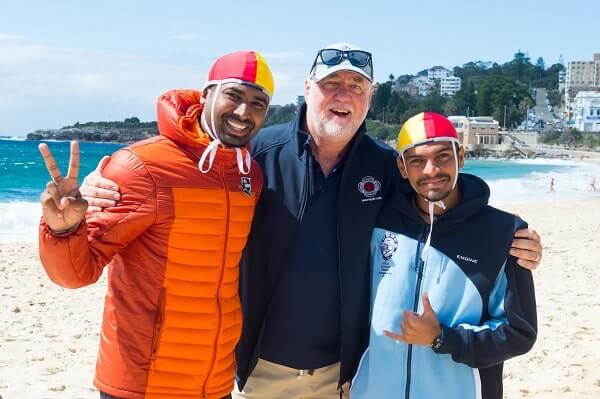I was three years old when it happened. It was a hot summer’s day with picnickers sitting under the shade of red river gums. A teenage boy was pulled from the muddy Murray River. He had told the boys that he could hold his breath for a long time and had jumped into the water to prove it. They waited for him to resurface but he never did. He was dead. I’ll never forget that day.

The tragedy is that many of us have witnessed something just as haunting. Each year around 300 people drown in Australia, a statistic that pales in comparison to the number of fatalities in India, where almost 30,000 drown each year, amounting to 43% of the total drownings worldwide.
When Coogee surf lifesaver Doug Hawkins visited India in 2015, he found out why. Hawkins, who was in India to provide training in surf lifesaving funded by the Australia-India Council, observed that many Indians didn’t recognise the dangers of the ocean. They waded in chest deep, were unable to swim and were weighed down since they were fully clothed. As well, surfing is a fast-growing sport with sixteen Indian clubs now established, but many surfers lack training in swimming and water safety. Doug was determined to do something about it.
Fast forward to 2018 and a new organisation, Surf Live Saving India, has been established. A Surf Life Saving Club has also been set up at Tannirubhavi beach in Mangalore. Forty-eight children aged 8-16 have now been provided training based on the Australian model of water safety, rescue skills/CPR, fitness, health and teamwork, and they have adopted the Australian name of Nippers.

“This is a great start for beach lifesaving in India,” says Doug, as he walks along Coogee beach that he helps to patrol. “It’s not just the kids who benefit, but the community as a whole, and opens up the subject of water safety awareness for the people and families who are involved.”
In January, two members of the Mangalore club – swim coach Niroop G R and surfer and coach Srikrishna (Satya) Vasantha – came to Australia to undertake a rigorous training program in beach patrol, gain know-how to run a Nippers program for children and become qualified Australian Surf Life Savers.
And that’s only the start. In August this year, a team of Surf Lifesavers from Coogee and other Sydney clubs will travel to Mangalore to provide training for 100 participants with the goal of having highly trained local lifesavers who will then have the capability to train others in surf lifesaving. The goal is to establish Surf Life Saving across India to make all beaches safe. That would be a remarkable achievement and one that would foster a spirit of goodwill and collaboration between Australia and India.

“The aim,” says Doug, “is to get a defined Beach Safety Centre Model up and running in Mangalore that other Councils can then adopt along the beaches of India to make the beaches safer.”
In Australia, there are currently around 65,000 Nippers aged 5 to 14. From the Nippers program, hundreds of new lifesavers graduate each season with their Surf Rescue Certificate to assist on the beach. They also learn water awareness skills, how to identify rips and people in danger and how to respond to these situations safely.
Doug Hawkins is a patrolling member of Coogee Surf Club, Trainer, Assessor and Facilitator, and Director of SLS Sydney Nippers. This project is being funded by Australian Surf Lifesavers. For more information or if you would like to support their endeavours go to https://chuffed.org/project/india-surf-lifesaving-training-in-australia
Doug’s tips for safe swimming at the beach
- Swim only between the flags so lifesavers who have already determined that this is the safest part of the beach can see you. Swim outside of the flags or at an unpatrolled beach and you’re on your own.
- Read the signs for information on rips and other dangers and ask the lifesavers for advice.
- Never swim at night or alone.
- If you go on your own to the beach, stay close to other swimmers.
- If you get caught in a rip, don’t panic. Fight it and it will tire you out. Stay calm, float on your back and try to attract attention by raising your hand. The rip will not take you under, just out to the end of the break, and may even bring you back on the broken waves.
- If you see someone in trouble in the water, call out for assistance. That’s the best help you can give.
- Australia has the highest incidence of skin cancer in the world and each year almost 2,000 people die from Melanoma. So protect yourself from the sun’s harmful rays. Always apply SPF50 sunscreen, wear a hat and sunglasses, avoid the sun during the middle of the day, and wear a “rashie” or swimming top with sleeves. Never enter the water fully clothed.
READ ALSO: Be water safe this summer
Link up with us!
Indian Link News website: Save our website as a bookmark
Indian Link E-Newsletter: Subscribe to our weekly e-newsletter
Indian Link Newspaper: Click here to read our e-paper
Indian Link app: Download our app from Apple’s App Store or Google Play and subscribe to the alerts
Facebook: facebook.com/IndianLinkAustralia
Twitter: @indian_link
Instagram: @indianlink
LinkedIn: linkedin.com/IndianLinkMediaGroup




